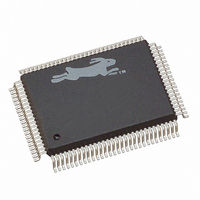20-668-0003 Rabbit Semiconductor, 20-668-0003 Datasheet - Page 177

20-668-0003
Manufacturer Part Number
20-668-0003
Description
IC CPU RABBIT2000 30MHZ 100PQFP
Manufacturer
Rabbit Semiconductor
Datasheet
1.20-668-0003.pdf
(228 pages)
Specifications of 20-668-0003
Processor Type
Rabbit 2000 8-Bit
Speed
30MHz
Voltage
2.7V, 3V, 3.3V, 5V
Mounting Type
Surface Mount
Package / Case
100-MQFP, 100-PQFP
Data Bus Width
8 bit
Maximum Clock Frequency
30 MHz
Operating Supply Voltage
0 V to 5.5 V
Maximum Operating Temperature
+ 85 C
Mounting Style
SMD/SMT
Minimum Operating Temperature
- 40 C
Number Of Programmable I/os
40
Number Of Timers
8 & 10 bit
Lead Free Status / RoHS Status
Lead free / RoHS Compliant
Features
-
Lead Free Status / Rohs Status
Lead free / RoHS Compliant
Other names
20-668-0003
316-1062
316-1062
Available stocks
Company
Part Number
Manufacturer
Quantity
Price
Company:
Part Number:
20-668-0003
Manufacturer:
Rabbit Semiconductor
Quantity:
10 000
- Current page: 177 of 228
- Download datasheet (2Mb)
17.3 Shadow Registers
Many of the registers of the Rabbit’s internal I/O devices are write-only. This saves gates
on the chip, making possible greater capability at lower cost. Write-only registers are eas-
ier to use if a memory location, called a shadow register, is associated with each write-
only register. To make shadow register names easy to remember, the word shadow is
appended to the register name. For example the register GOCR (Global Output Control
register) has the shadow
source code as shown below.
If the port is a write-only port, the shadow register can be used to find out the port’s con-
tents. For example GCSR has a number of write-only bits. These can be read by consult-
ing the shadow, provided that the shadow register is always updated when writing to the
register.
17.3.1 Updating Shadow Registers
If the address of a shadow register is passed as an argument to one of the functions that
write to the internal or external I/O registers, then the shadow register will be updated as
well as the specified I/O register.
A
and
to the shadow register is mandatory for
17.3.2 Interrupt While Updating Registers
When manipulating I/O registers and shadow registers, the programmer must keep in
mind that an interrupt can take place in the middle of the sequence of operations, and then
the interrupt routine may manipulate the same registers. If this possibility exists, then a
solution must be crafted for the particular situation. Usually it is not necessary to disable
the interrupts while manipulating registers and their associated shadow registers.
17.3.2.1 Atomic Instruction
As an example, consider the parallel port D data direction register (PDDDR). This register
is write only, and it contains 8 bits corresponding to the 8 I/O pins of parallel port D. If a
bit in this register is a “1,” the corresponding port pin is an output, otherwise it is an input.
It is easy to imagine a situation where different parts of the application, such as an inter-
rupt routine and a background routine, need to be in charge of different bits in the PDDDR
register. The following code sets a bit in the shadow and then sets the I/O register. If an
interrupt takes place between the
PDDDR, the correct value will still be set in PDDDR.
Chapter 17 Other Rabbit Software
NULL
WrPortE()
char GCSRShadow; // Global Control Status Register
char GOCRShadow; // Global Output Control Registe
char GCDRShadow; // Global Clock Doubler Register
k=GCSRShadow;
pointer may replace the pointer to a shadow register as an argument to
; the shadow register associated with the port will not be updated. A pointer
GOCRShadow
set
and the
. Some shadow registers are defined in the BIOS
BitWrPortI()
ldd
, and changes the shadow register and
and
BitWrPortE()
r
WrPortI()
.
171
Related parts for 20-668-0003
Image
Part Number
Description
Manufacturer
Datasheet
Request
R

Part Number:
Description:
IC CPU RABBIT4000 128-LQFP
Manufacturer:
Rabbit Semiconductor
Datasheet:

Part Number:
Description:
IC MPU RABIT3000A 55.5MHZ128LQFP
Manufacturer:
Rabbit Semiconductor
Datasheet:

Part Number:
Description:
Microprocessors - MPU Rabbit 3000 TFBGA Microprocessor
Manufacturer:
Rabbit Semiconductor

Part Number:
Description:
Microprocessors - MPU Rabbit 4000 LQFP Microprocessor
Manufacturer:
Rabbit Semiconductor

Part Number:
Description:
IC, I/O EXPANDER, 8BIT, 40MHZ, TQFP-64
Manufacturer:
Rabbit Semiconductor

Part Number:
Description:
SCRs 1.5A 200uA 400V Sensing
Manufacturer:
Littelfuse Inc
Datasheet:

Part Number:
Description:
CARD 6-RELAY SMARTSTAR SR9500
Manufacturer:
Rabbit Semiconductor
Datasheet:

Part Number:
Description:
WIRE-BOARD CONN RECEPTACLE, 6POS, 3.96MM
Manufacturer:
TE Connectivity
Datasheet:

Part Number:
Description:
ADAPTER 20 PIN .420" PLUGS(6PCS)
Manufacturer:
Logical Systems Inc.
Datasheet:

Part Number:
Description:
CONN BARRIER BLOCK .438" 20 POS
Manufacturer:
Cinch Connectors
Datasheet:

Part Number:
Description:
20 MODII 2PC HDR DR SHRD, ROHS
Manufacturer:
TE Connectivity
Datasheet:

Part Number:
Description:
WIRE-BOARD CONN RECEPTACLE, 6POS, 3.96MM
Manufacturer:
TE Connectivity
Datasheet:














